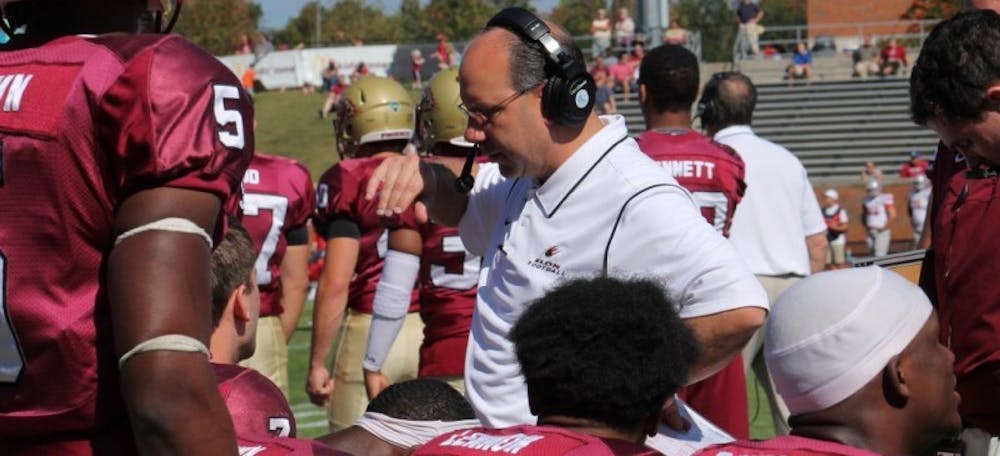As he sat back in his chair, an iPhone 6 in front of him, Rich Skrosky couldn’t help but laugh.
The Elon University football head coach was thinking back to the early days of college coaching and reminiscing about how recruiting used to be.
And just how crazy it seems today.
“The kids can’t even fathom that mentality,” Skrosky laughs, then restarts. “High schools back then were on 16-millimeter film. If you were a high school, you had one film for a game — there weren’t multiple copies.
“So as the recruiting coach, you couldn’t go say, ‘Hey coach, we like these two kids at your school. Send us film.’ They did on occasion, but if you didn’t get that film back to them within days, you would be barred from that school.”
The exponential developments in technology since the 1980s have completely changed the way sports exist in many different facets.
But in collegiate athletics, the recruiting realm has been completely reworked 10 times over, and continues to develop faster than the NCAA can keep up with.
Skrosky’s start in college coaching came about a decade before head men’s basketball coach Matt Matheny started as an assistant at Davidson College, but he also remembers the irregularity of film coaches could find on recruits.
“In years’ past, you’d find out about a kid and you’d have to rely on that high school having filmed their games, which was not a guarantee,” Matheny said. “If they did film their games, the high school coach — who has a million things to do — would have to take the time to make a copy of the film and send it to you via UPS. I remember years where on my desk I’d have stacks of VHS tapes — some of the people I knew and some I didn’t.”
But video-based recruiting websites, such as Hudl, have made physical tapes obsolete, and Skrosky sees that as just one of the ways that makes the “process so much easier.”
Skrosky said the first technological advance he found useful was calling cards, which helped avoid running up expenses on a coach’s home phone or being forced to stay in the office all night.
“My first cellphone was 1999,” Skrosky adds. “They weren’t flip phones, and they had antennas. Whether that antenna did anything, I don’t know.”
And now, as smartphones become the norm, colleges have tried to find ways to make sure they are being compliant to NCAA rules, despite the rules being outdated.
“I think the rules will continue to change, as technology has certainly bypassed the rules,” Skrosky said. “It’s like, ‘C’mon. Really? You can’t text but you can IM a kid? Isn’t that a text of some sort?’ It can’t [keep up].”
JumpForward is a software company based in Chicago that claims to have more than 180 athletic departments using its services. Elon has used JumpForward for five years now, and Skrosky heaped praise on the database.
“Everything is literally on your device, whether it’s an iPad or phone,” Skrosky said. “It’s not just the accessibility of it, but it’s a compliance issue. When I go to call a recruit, I’ll get a message up top and it will tell me, ‘I can’t call,’ or it will tell me, ‘I have unlimited calls,’ or, ‘You can only call this kid once a week.’”
Skrosky remembers when he had to keep track of everything by hand, calling the task arduous. But JumpForward has changed that, allowing coaches to keep a running track of everything pertaining to recruits.
“These companies became more prevalent when schools got hit with a violation of too much texting,” Skrosky said. “Some of these software companies have sold their software to the administration, not even the coaches. The software can come to the administration and say, ‘We have this software that will keep you compliant.’”
According to Assistant Director of Compliance Jeffrey Scheible, Elon was among the first 10 to 15 schools to use JumpForward, and the school has been “a guinea pig” for the service. Scheible serves on JumpForward’s Development Council, helping the company grow and expand by giving suggestions on what is needed.
Yet for all that the technological improvements can do to help a program recruit, Skrosky doesn’t let the technology be the only thing that he uses to recruit players.
Instead, he said technology can be a “great instrument” to help figure out which kids he likes, but the intangibles still matter more.
“We still know the hardest thing to evaluate is intangibles,” Skrosky said. “If we know the intangibles are the hardest thing to evaluate, and the NFL hits at about a 55 percent rate, and they spend millions and millions of dollars, countless amount of hours.
“If you hit a 55 percent at Elon, your ass gets thrown out. You’re failing. So where do they miss? They miss in the intangible, the character, the toughness, the coachability.”
Skrosky is aware that Elon may “do things a little different” than other schools, but he thinks it’s vital for the Phoenix to be selective of who gets scholarships.
“Some don’t care, but [scholarships] are too valuable,” Skrosky said. “When we offer a kid a scholarship here, we’re basically offering that kid a quarter of a million dollars. That’s a big investment. And I’m going to do it on a four-minute highlight and 40 characters? You’ve got to go deeper than that.”
It’s what has driven Skrosky to recruit the specific type of kids he does — or what Matheny refers to as the “Elon man” — that technology can’t show you.
“It is a tool, but don’t let it control you,” Skrosky said.


